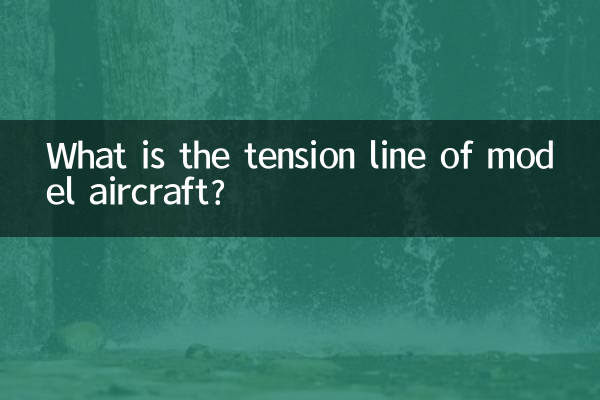What is the tension line of model aircraft?
Model aircraft tension lines are an important concept in aviation model flight, especially playing a key role in the design and flight of fixed-wing model aircraft. It directly affects the flight performance and stability of the aircraft model. This article will introduce in detail the definition, function, adjustment method and related data of the aircraft model tension line.
1. Definition of model aircraft tension line

The tension line of the aircraft model refers to the relative positional relationship between the thrust line generated by the aircraft model's engine or motor and the center of gravity of the aircraft model. Simply put, it is the line between the direction of thrust and the center of gravity of the aircraft model. The correct setting of the tension line can ensure that the aircraft model maintains a stable attitude during flight.
2. The function of the aircraft model tension line
The main functions of aircraft model tension lines include:
1.Maintain flight stability: The correct tension line can reduce the pitch and yaw changes of the aircraft model during flight.
2.Improve flight efficiency: Reasonable tension line settings can reduce unnecessary energy loss and improve the endurance of the aircraft model.
3.Reduce control difficulty: Model aircraft with properly set tension lines are easier to control, especially suitable for novice pilots.
3. Adjustment method of the tension line of the aircraft model
The adjustment of the tension line of the aircraft model is usually achieved by changing the installation angle of the engine or electric motor. The following are common adjustments:
| Adjust direction | function | FAQ |
|---|---|---|
| Drop down corner | Counteract head-up tendency in flight | Excessive pull-down angle will cause the model aircraft to bow its head. |
| Right pull corner | Counteract propeller back torque | Excessive right pull angle will cause the model aircraft to veer to the right. |
| left angle | Used in special circumstances | rarely used |
4. Common problems and solutions for aircraft model tension lines
In actual flight, the following problems may occur in the setting of the tension line of the aircraft model:
| Problem phenomenon | Possible reasons | solution |
|---|---|---|
| Keep looking up during flight | Insufficient drop-down angle | Add drop-down angle |
| Continuously lower your head during flight | The drop-down angle is too large | Reduce drop-down angle |
| Continuously drifting to the right during flight | The right pull angle is too large | Reduce right draw angle |
| Continuous deviation to the left during flight | Insufficient right pull angle | Increase the right pull angle |
5. Reference data of aircraft model tension lines
The tension line settings of different aircraft models will be different. The following is the reference data of the tension lines of some common aircraft models:
| Model aircraft type | Pull-down angle (degrees) | Right pull angle (degrees) |
|---|---|---|
| aerobatic model aircraft | 1-2 | 2-3 |
| trainer aircraft | 2-3 | 1-2 |
| Like real machine | 0-1 | 1-2 |
| glider | 3-4 | 0-1 |
6. Practical application cases of aircraft model tension lines
In actual model aircraft flight, the adjustment of the tension line often needs to be combined with the flight performance. The following is an actual adjustment case:
A certain aircraft model enthusiast discovered during flight that his aerobatic model aircraft had an obvious tendency to raise its head when flying at high speed. After inspection, it was found that the pull-down angle was set to 0 degrees. According to the reference data, after he adjusted the pull-down angle to 1.5 degrees, the flight stability of the model aircraft was significantly improved.
7. The future development trend of aircraft model tension lines
With the continuous development of aircraft model technology, the concept of tension lines is also constantly evolving:
1.Electronic tension line compensation: Some advanced model aircraft flight control systems can electronically compensate for tension line deviations.
2.Variable tension line system: Some high-end model aircraft have begun to try to use adjustable tension line systems to adapt to different flight conditions.
3.computer aided design: An increasing number of aircraft model designers are using computer simulations to optimize tension line settings.
8. Summary
The tension line of model aircraft is a seemingly simple but very important concept in model aircraft flight. Correct tension line settings can significantly improve the flight performance and controllability of the aircraft model. When assembling and debugging model aircraft, enthusiasts should pay special attention to the setting of the tension lines and make appropriate adjustments based on actual flight performance.
As aircraft model technology advances, the concept of tension lines continues to evolve. Understanding and mastering the principles and adjustment methods of tension lines will help model aircraft enthusiasts better enjoy the fun of model aircraft flying.

check the details

check the details